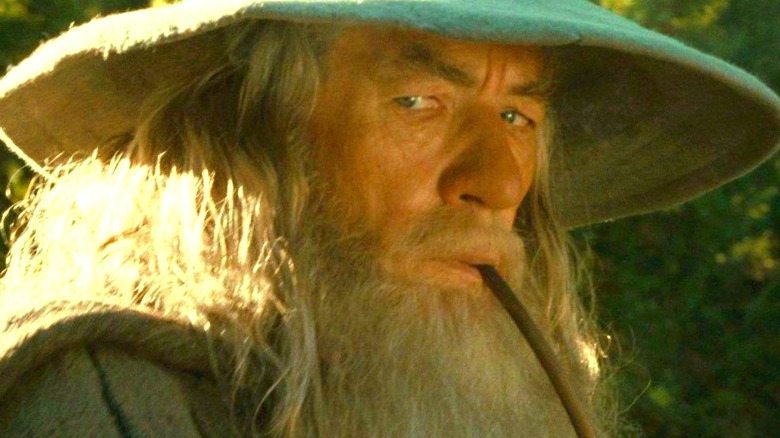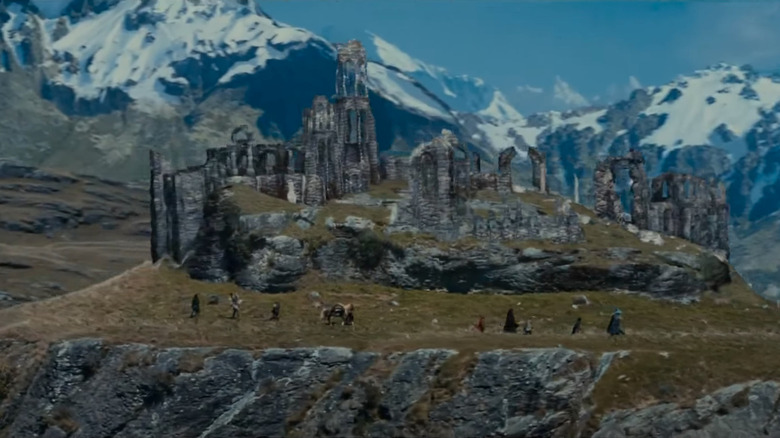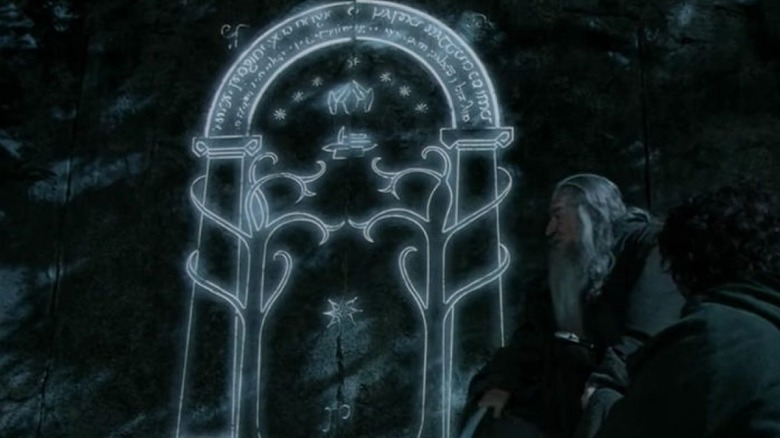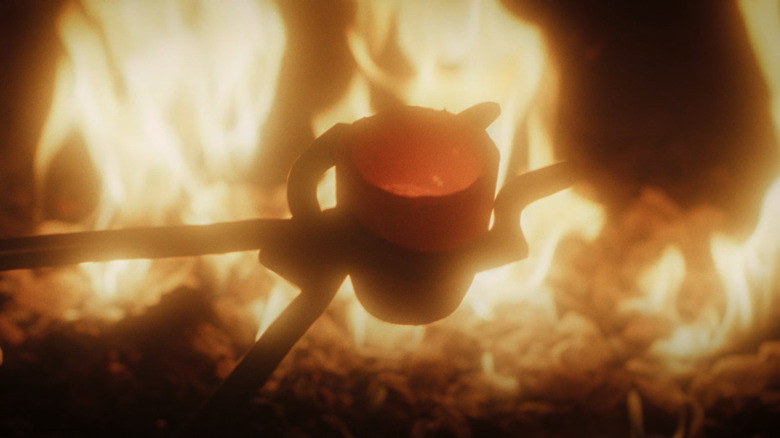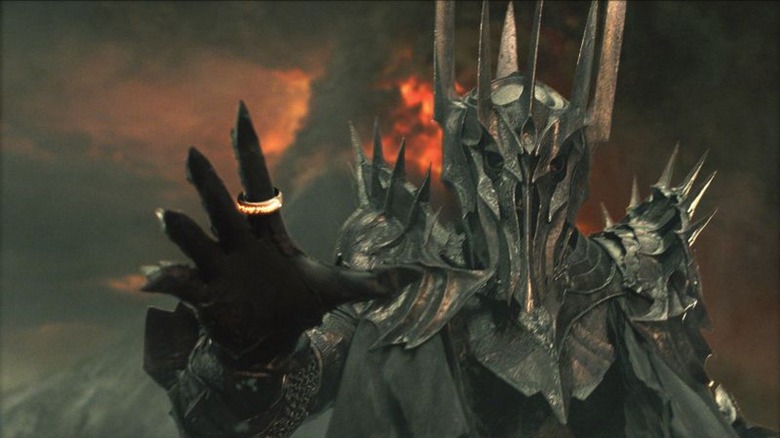The Lord Of The Rings: The Rings Of Power's Celebrimbor Explained
"The Lord of the Rings: The Rings of Power" is juggling a massive cast made up of 23 main characters (via The Mary Sue). This crowd includes a mixture of well-known canon names and many entirely new faces.
One of the names that comes directly out of Tolkien's writings is Celebrimbor. While it's been known from early on that Celebrimbor would be played by Charles Edwards, there was no sign of this famous, tragic Elf in any of the promotional material — no sign, that is, until Empire Magazine released an exclusive image of Celebrimbor.
The actual picture doesn't reveal much apart from a stern-looking Elven lord gazing off into the distance as he stands in what appears to be a stone hall. Though details are scarce, it's the unveiling of the character in all of his dramatic glory that really matters here. Celebrimbor isn't just another name from Tolkien's world. He's a central character in the Second Age of Middle-earth, and he plays a critical role in the "Rings of Power" story.
Remember that ring that Galadriel is wearing when she shows Frodo her mirror? Yeah, Celebrimbor made it. Remember all of those other Dwarven, Nazgûl, and Elven rings we see at the beginning of "The Fellowship of the Ring" movie? He was part of their forging too. Heck, remember the famous doors of Moria that open at the too-casual password of "friend?" That's Celebrimbor.
But we're getting ahead of ourselves here. Let's head to the source material and go through this Elven lord's history from the beginning to get an idea of just what he could be up to as the "Rings of Power" story unfolds over the next several years.
Celebrimbor has a pretty vague early history
Like many of the immortal Elves in Tolkien's world, Celebrimbor's earliest days are hazy. He lives for a while in the Blessed Realm (where Frodo and Bilbo sail at the end of "The Return of the King) before coming over to mainland Middle-earth during the First Age. That's the 600-year period right before "Rings of Power" is set. It's the part of Middle-earth history where Sauron's original master, Morgoth, dukes it out with the Elves and is eventually overthrown in the world-breaking War of Wrath.
Tolkien wrote a few different versions of Celebrimbor's backstory during this early time. Sometimes he's described as a highly-skilled Elven artificer or jewel-smith. Both of these descriptions make sense. After, all, according to "The Peoples of Middle-earth," the name Celebrimbor literally means "silverfisted." He's also fully titled "Celebrimbor of the Silver Grasp." In "Unfinished Tales," his name is also translated as "Hand of Silver." No matter what way you forge it, this guy likes to work with hot metals.
Of Celebrimbor's many origin stories, though, the most common one — and the one that made it into the officially printed account in "The Silmarillion" — is that he's the grandson of Fëanor, the greatest Elven smith to ever live. Fëanor is the forger of the three Silmarils that "The Silmarillion" is named after. He may have also created the seeing stones called the Palantíri.
Celebrimbor follows in his grandad's footsteps and becomes one of the most celebrated smiths in all of Middle-earth's long history. In fact, he's even described in Unfinished Tales as having "an almost 'dwarvish' obsession with crafts." Even in this more important role, though, Celebrimbor's First Age history is mostly quiet. It isn't until the Second Age that he fully comes into the spotlight.
Celebrimbor the good and wise leader of Eregion
While Celebrimbor mirrors the craftsman-like skills of his ancestors, he's nothing like his grandfather or even his father, Curufin, when it comes to temperament. Both Fëanor and Curufin are nasty dudes with bad tempers who make a lot of antagonistic mistakes. In contrast, Celebrimbor publicly repudiates his dad's bad M.O. and chooses to find new friends ... including Celeborn and Galadriel. Notably, one version of the text hints that he has feelings for Galadriel, even though he accepts that she chose Celeborn instead of himself.
While Celebrimbor's reputation is overwhelmingly focused on his abilities as a craftsman, he also has a royal pedigree. This lofty status means he becomes the Lord of Eregion during the Second Age. That's the same area where the Fellowship of the Ring is ambushed by Sauron's flying spies as they travel toward Moria thousands of years later. During the Second Age, this region is still thriving, and Celebrimbor leads from the capital Elvish city of Ost-in-Edhil.
There isn't a lot about his time as a leader, and in typical fashion for Tolkien's Second Age material, there are multiple versions of the events that take place. In fact, one version in "Unfinished Tales" even talks about Celebrimbor being convinced by Sauron in disguise to revolt against Galadriel's leadership.
Based on most writings, though, there is no revolt. Sure, Celebrimbor disagrees with Galadriel on some pretty important stuff — which we'll cover in a minute — but he leads the area in relative peace. He also strikes up an important friendship with his nearby neighbors ...the Dwarves of Khazad-dûm.
Celebrimbor the craftsman
One of the main reasons Celebrimbor is attracted to the area that he eventually rules is because it's near Khazad-dûm. It's important to note that this guy is remembered for having a "dwarvish" obsession with smithcraft. And what's in Moria? That's right. Mithril. Celebrimbor hears of the marvelous metal and is so intrigued that it initially attracts him to the area. In the centuries that follow, Celebrimbor becomes as good as the Dwarves themselves when it comes to working with their precious, shiny, subterranean mineral.
The Elven lord's reputation as a smith is also bolstered by the fact that Celebrimbor becomes the head of a group of Elven smiths in Eregion called the Gwaith-i-Mírdain. "The Silmarillion" summarizes this group and its leader nicely when it says, "In Eregion the craftsmen of the Gwaith-i-Mírdain, the People of the Jewel-smiths, surpassed all that have ever wrought, save only Fëanor himself; and indeed greatest in skill among them was Celebrimbor, son of Curufin, who was estranged from his father..."
Before we get to the Rings of Power stuff that we all know is coming, there's one more fun fact to point out. At one point along the way, Celebrimbor takes on a glorified arts-and-crafts project with Narvi, a renowned Dwarven smith from Khazad-dûm and a personal friend. Together, the two famous craftsmen (or "craft-elf" and "craft-dwarf" to be more precise) create the Doors of Durin — that is, the doors that Gandalf later opens right before the Watcher in the Water attacks Frodo. The whole "speak friend, and enter" bit is fun on its own, but knowing that Celebrimbor and his bestie, Narvi, made the doors together is a fun bit of Middle-earth trivia.
Okay, now on to the more serious stuff.
Celebrimbor makes the Rings of Power
Celebrimbor's greatest accomplishments come in the form of the Rings of Power. In fact, he's involved in forging all of the Rings of Power with the exception of the One Ring itself.
See, when the Second Age gets going, Sauron starts in hiding. When he stirs again, rather than turning into the nasty brute we're used to seeing in Peter Jackson's films, he disguises himself as the attractive "Annatar, the Lord of Gifts" and visits the Elves, offering them his "help." Folk like Galadriel and Elrond are wary of this stranger, but in Eregion, Celebrimbor and his fellow smiths welcome Annatar's disarming personality and wonderful knowledge with open arms. They also use his help and wisdom to start creating powerful Rings.
"The Silmarillion" explains, "Therefore they hearkened to Sauron, and they learned of him many things, for his knowledge was great. In those days the smiths of Ost-in-Edhil [...] took thought, and they made Rings of Power. But Sauron guided their labours, and he was aware of all that they did..." The section ends with the foreboding line that Sauron's "desire was to set a bond upon the Elves and to bring them under his vigilance."
The one bright spot throughout this time is that Celebrimbor uses his newfound Ring knowledge to create three powerful Rings without Sauron's help. These end up being the Three Elven Rings, which he later hides from the Dark Lord, including by sending one of them to Galadriel in Lothlorien.
In the end, Celebrimbor discovers that this nice Annatar guy is actually Sauron in disguise. And how does he find out? Why, when Sauron puts on the One Ring and tries to start controlling all of the other Rings of Power and their wearers, of course.
Celebrimbor meets his doom
When Celebrimbor and the other Elves realize that Sauron has betrayed them, they take off their Rings and hide them. This infuriates Sauron, who puts Plan B into motion: unleashing all-out war.
Sauron attacks the Elvish lands, starting with Eregion, where Celebrimbor is busy preparing to fight him. But Sauron's armies are too strong, and the Elven lord and smith is captured. In "Unfinished Tales," it says that Celebrimbor's last stand is made defending the House of the Mírdain, the headquarters of the Gwaith-i-Mírdain, adding that "Celebrimbor, desperate, himself withstood Sauron on the steps of the great door of the Mírdain; but he was grappled and taken captive, and the House was ransacked." Sauron captures the Nine Rings (which he later gives to Men) right away. He tortures Celebrimbor and discovers where the Seven Rings (later given to the Dwarves) are, too. But he can't get any information about the Three Elven Rings, so he has Celebrimbor put to death. Yeah. Brutal.
The last time we see Celebrimbor is equal parts gruesome and tragic. His body is filled with arrows and then put on a pole and used as a banner for Sauron's armies as the Dark Lord continues to attack other Elves in Middle-earth.
And that's it. That's the story of Celebrimbor. He's an Elf that rejects his ancestor's sins and works hard to rectify them ... only to unleash the events that ultimately culminate in the War of the Ring. While there's plenty of bad stuff to point to, though, in the end, Celebrimbor's actions are what lead Sauron to put so much of his power into the One Ring. This sets up the one-in-a-million chance Frodo takes to destroy said bauble and finally defeat Sauron once and for all, nearly 5,000 years later.
